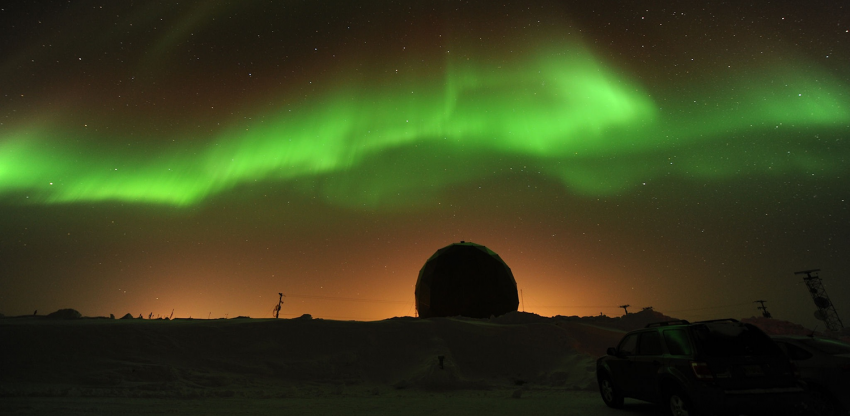In the Northern and Southern Hemispheres, at certain latitudes, beautiful auroras are known to light up the sky on clear nights. These phenomena are known as the Aurora Borealis (Northern Lights) and the Aurora Australis (Southern Lights). They might be pretty to glance at, but can also be dangerous to the Earth.
These auroras are caused by geomagnetic storms, a disturbance in Earth’s magnetosphere, which is part of Earth’s upper atmosphere. They result from large eruptions from the Sun known as Coronal Mass Ejections (CME). The large CME eruptions cause a phenomenon known as the Solar Wind which can reach a temperature of one million degrees on the surface of the sun and can travel toward the Earth at speeds of over one million miles per hour! A more concentrated event that occurs from a CME is known as a solar flare. These are what usually cause the most intense geomagnetic storms.
Here is a picture (courtesy of NASA) of how a Coronal Mass Ejection and Solar Flare (orange/red color) might look like as it approaches Earth’s magnetosphere (purple). Earth’s magnetic field can be seen in blue.
From the picture, notice that Earth’s magnetic field is strongest at the North and South Poles. When the pressure of the Solar Wind exerts a larger than normal force on Earth’s magnetosphere, this causes a buildup of energy to be shifted toward where Earth’s magnetic field is strongest. Particles embedded in the energy exerted by the Solar Wind reach high enough speeds to penetrate Earth’s upper atmosphere called the ionosphere. Here, these particles react with gases present in the upper atmosphere and cause the beautiful colors associated with the Auroras. CMEs consist of different gases which result in different colors seen in the sky during a geomagnetic storm. Oxygen tends to produce a greenish color, helium tends to produce more of a red, and Nitrogen produces a blue color. Depending on the strength of a geomagnetic storm, viewing may extend farther away from the poles where skies are clear at night. During the wintertime, the Aurora Borealis is easily viewable in Alaska and portions of Central Canada. In some rare occurrences during more prominent geomagnetic storms, auroras can be visible from the central and southern U.S States. Geomagnetic storms are known to last for a few days before subsiding in intensity.
Do not mistake the beauty of a geomagnetic storm to be all good. Depending on their overall strength, geomagnetic storms can have devastating impacts on Earth. Though the magnetosphere protects us at the surface from the high energy particles from CMEs, these particles can manage to disrupt communications, electrical power, and the operation of satellites. Since these particles possess large amounts of energy, they tend to induce more geomagnetic current into transformers leading to failures of power grids and electrical fires. The most devastating impact geomagnetic storms have on Earth is how often they can disrupt communications. Flights are often rerouted away from the North and South Poles due to forecasted geomagnetic storms because the storms can often disable communication from an aircraft to ground personnel. The following diagram by F. Michael Maloof (former senior security policy analyst in the office of the secretary of defense) illustrates various effects that CMEs have on Earth.
The ability to forecast geomagnetic storms is very difficult because there are different variables that go into predicting space weather. However, as a CME approaches Earth, more information can be gathered and an accurate forecast can be made. The Space Weather Prediction Center uses different indices to determine when, and how intense, a storm might be. Two well known indices are the K-Index and the Planetary A Index. The K-Index is a measure of how disturbed the horizontal component of Earth’s magnetic field will be over a 3 hour period and the A-Index is a daily average of geomagnetic activity. The table below from the Space Weather Prediction Center breaks down what each value corresponds to.
Looking at the forecast through the beginning of October, geomagnetic storm conditions will be unsettled, but remaining relatively quiet.



